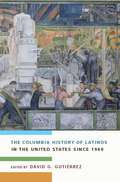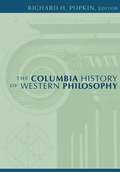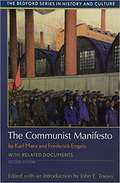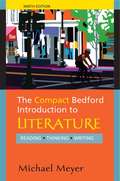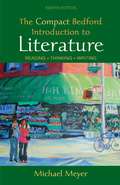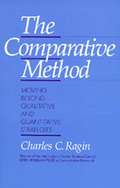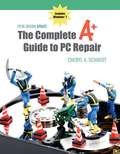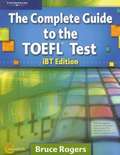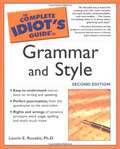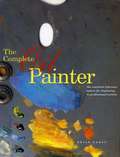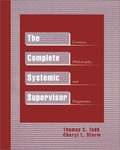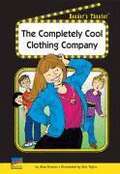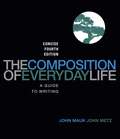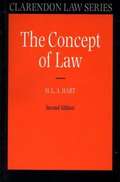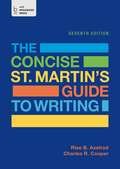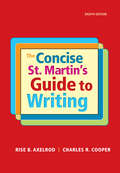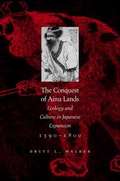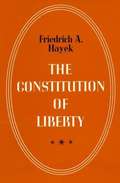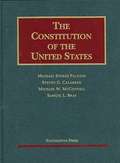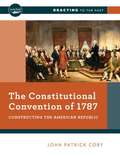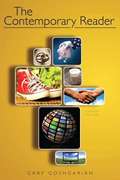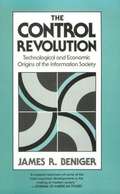- Table View
- List View
The Columbia History of Latinos in the United States Since 1960
by David G. GutiérrezThis volume provides not only cutting-edge interpretations of recent Latino history, including the six major groups (Mexicans, Cubans, Puerto Ricans, Dominicans, Central Americans, and South Americans), but also insight into the major areas of contention and debate that characterize Latino scholarship in the early twenty-first century. Important political and cultural themes that cut across group boundaries-such as Latino religiosity, gender systems, politics, expressive cultures, and interactions with the law-are examined from a multinational perspective, shaping a realistic interpretation of the Latino experience in the United States.
The Columbia History of Western Philosophy
by Richard H. PopkinRichard Popkin has assembled sixty-three leading scholars to forge a highly approachable chronological account of the development of Western philosophical traditions. From Plato to Wittgenstein and from Aquinas to Heidegger, this volume provides lively, in-depth, and up-to-date historical analysis of all the key figures, schools, and movements of Western philosophy. Each chapter includes an introductory essay, and Popkin provides notes that draw connections among the separate articles. The rich bibliographic information the and the indexes of names and terms make the volume a valuable resource.
The Communist Manifesto: With Related Documents (Bedford Series in History and Culture)
by Karl Marx Frederick Engels John E. ToewsDoes the closing of the cold war era open up the possibility of reading the Communist Manifesto in new ways? In the first teaching edition of the post-Cold War era, Toews proposes new guidelines for reassessing the work to help students reconstruct the meaning of the Manifesto in its time and at the close of the twentieth century. Together with the complete text of the work, this brief volume includes some key foundational documents by Hegel, Feverbach, Marx, Engels, and others that show the evolution of and influences on Marxist theory over time. The editor's introduction traces the trajectory of Marx's thought from the 1830s onward, while providing background on the political, social, and intellectual contexts of which the Manifesto was a historical product.
The Community of Washington, D.C.
by Bernice RappoportPerform this script about four trick-or-treaters who use math skills to share their Halloween candy.
The Compact Bedford Introduction to Literature: Reading, Thinking, Writing
by Michael MeyerThe Compact Bedford Introduction to Literature is a best-seller for a reason: it brings literature to life for students -- helping to make them lifelong readers and better writers. Classic works from many periods and cultures exist alongside a diverse representation of today's authors. Support for students includes a dozen chapters of critical reading and writing, with plenty of sample close readings, writing assignments, and student papers. And, because everyone teaches a little differently, there are lots of options for working with the literature, including in-depth chapters on major authors and case studies on individual works and themes that everyone can relate to. New to this edition are casebooks on short fiction and the natural world and a chapter created with Billy Collins. This anthology is now available with video! Learn more about VideoCentral for Literature.
The Compact Bedford Introduction to Literature: Reading, Thinking, Writing (8th Edition)
by Michael MeyerThe Compact Bedford Introduction to Literature is designed to bring literature to life -- and to make students lifelong readers. As an instructor of literature and writing, editor Michael Meyer understands that a particular challenge in today's classroom is that students may not see literature as relevant to their lives. They may have difficulty reading it critically and lack confidence in their writing skills. With these factors in mind, Meyer has put together a lively collection of literature drawn from many periods, cultures, and voices, with an excellent representation of contemporary authors, women authors, and authors of color. These works are presented with more than a dozen chapters of critical reading and writing support, and a generous helping of sample close readings, writing assignments, and student papers. And, because everyone teaches a little differently, the book offers more options for working with the literature than any comparable anthology -- including in-depth chapters on major authors and case studies on individual works and universal themes.
The Comparative Method: Moving Beyond Qualitative and Quantitative Strategies
by Charles C. RaginProfessor Ragin proposes a synthetic new strategy, based on an application of Boolean algebra, that will combine the strengths of both qualitative and quantitative sociology. Elegantly accessible and germane to the work of all the social sciences, this book will garner interest, debate, and praise from many quarters.
The Complete A+ Guide To PC Repair Fifth Edition Update (5th Edition)
by Cheryl SchmidtCheryl Schmidt's The Complete A+ Guide to PC Repair, Fifth Edition Update presents the fundamentals of computer desktop and laptop installation, configuration, maintenance, and networking through simple, step-by-step instruction based on CompTIA A+®2011 Edition objectives. With a focused emphasis on security and customer service skills, this comprehensive book on computer repair introduces the most important tools students need to become professional, customer-friendly technicians using today's technology. The A+ Certification Exam criteria are being updated, effective January 2011, to include Windows 7. The Fifth Edition Update now includes Windows 7 material.
The Complete Guide to the TOEFL Test (iBT Edition)
by Bruce RogersThe instruction and practice in the Complete Guide to the TOEFL iBT closely mirrors the actual test, helping students to master the skills necessary to achieve the best possible score on the TOEFL iBT test and prepare them for success in an academic setting.
The Complete Idiot's Guide to Grammar And Style
by Laurie E. RozakisYou're no idiot, of course. You've probably written your share of book reports,, term papers, e-mails, and thank you notes. The rules of writing can be confusing, however, and might result in final drafts riddled with gaffes, typos, and errors! The Complete Idiot's Guide® to Grammar and Style, Second Edition, will take you step by step through the basics of spelling, punctuation, and sentence formation to help you become an effective communicator of the written word! In this revised and updated Complete Idiot's Guide®, you get: Explanations of writing styles including exposition, narration, argumentation, and description. Definitions of such writing mistakes as dangling modifiers, mixed metaphors, and split infinitives–and how to avoid them. Examples of model documents such as resumes, cover letters, and thank you notes. The differences between drafting a business letter and crafting a personal one.
The Complete Oil Painter: The Essential Reference For Beginners To Professionals
by Brian GorstCompared to watercolor, encaustic, fresco, or tempera, oil paint is a relatively recent medium. It has its origins in northern Europe at the start of the fifteenth century, when drying oils were often added to the egg-yolk medium of tempera, possibly during the later applications of paint. Artists found that by painting in slow-drying oil paint, with its smooth modeling and richness of color, they could achieve greater realism. This, along with the durability of its paint film and the portability of its supports, meant that by the middle of the sixteenth century oil painting had spread throughout Europe to become the medium of choice for most painters. It has since dominated palettes up to the present day, with only the introduction of acrylics during the twentieth century offering any credible alternative to some of the uses of oils.
The Complete Systemic Supervisor: Context, Philosophy, and Pragmatics
by Cheryl L. Storm Thomas C. ToddThanks to the input from numerous supervisors representing a wide variety of settings, theoretical models and backgrounds, this has become the definitive text on clinical supervision from a systemic perspective. It contains a wealth of material for beginning and experienced supervisors, regardless of theoretical persuasion. It is suitable as a text on MFT supervision or for a prominent place on the bookshelf of practicing supervisors.
The Composition of Everyday Life (Concise Fourth Edition)
by John Mauk John MetzShowing students that the act of writing is connected to everyday living, THE COMPOSITION OF EVERYDAY LIFE emphasizes invention while helping student writers rediscover concepts, uncover meaning, and rethink the world around them.
The Concept of Law (2nd Edition)
by H. L. A. HartH L A Hart's The Concept of Law is the classic text for the study of jurisprudence and legal philosophy and is probably the most important work of legal philosophy written this century. This second edition is particularly valuable as it combines Hart's original text with a postscript, in which he responds to criticisms of his theory levelled by such notable scholars as Dworkin, Fuller and Finnis. Written by him but only discovered after his death, it has been ably edited by JosephRaz and Penelope Bulloch of Balliol College, Oxford.
The Concise St. Martin's Guide to Writing, Seventh Edition
by Rise B. Axelrod Charles R. CooperThe new Concise St. Martin’s Guide provides streamlined coverage of the six most commonly assigned genres in first-year composition—remembering events, writing profiles, explaining concepts, arguing a position, proposing a solution, and justifying an evaluation. The Concise Guide leads students through the writing process: "Guides to Reading" equip students to analyze a genre’s basic features, and Axelrod and Cooper’s distinctive "Guides to Writing" help students apply their analysis of reading to the development of their own writing projects. With more hands-on activities for critical reading and working with sources, greater emphasis on the rhetorical situation, and a fresh new design to show students the strategies they need at a glance, the Concise Guide helps students accomplish their writing goals from start to finish. Our newest set of online materials, LaunchPad Solo, provides all the key tools and course-specific content that you need to teach your class. Get all our great course-specific materials in one fully customizable space online; then assign and mix our resources with yours. To package LaunchPad Solo free with The Concise St. Martin's Guide to Writing, use ISBN 978-1-319-00686-0.
The Concise St. Martin’s Guide to Writing (Eighth Edition)
by Rise B. Axelrod Charles R. CooperThe new Concise St. Martin's Guide to Writing provides streamlined coverage of the six most commonly assigned genres in first-year composition, including remembering events, writing profiles, explaining concepts, arguing a position, proposing a solution, and justifying an evaluation. The Concise Guide leads students through the writing process: Guides to Reading equip students to analyze a genre's basic features, and Axelrod and Cooper's distinctive Guides to Writing help students apply their analysis of reading to the development of their own writing projects. With a new introductory chapter ("Composing Literacy") on writing a literacy narrative, a new assignment chapter on analyzing and synthesizing opposing arguments, and a new chapter on analyzing and composing multimodal texts, the Concise Guide helps students accomplish their writing goals from start to finish.
The Connecticut Adventure
by John W. IfkovicThe Connecticut Adventure is a 4th grade Connecticut history textbook. The outline for this book is based on the Connecticut Social Studies Curriculum Framework, it teaches history, civics and government, geography, and economics. The book places the state's historical events in the context of our nation's history.
The Conquest of Ainu Lands: Ecology and Culture in Japanese Expansion, 1590-1800
by Brett L. WalkerThis model monograph is the first scholarly study to put the Ainu--the native people living in Ezo, the northernmost island of the Japanese archipelago--at the center of an exploration of Japanese expansion during the seventeenth and eighteenth centuries, the height of the Tokugawa shogunal era. Inspired by "new Western" historians of the United States, Walker positions Ezo not as Japan's northern "frontier" but as a borderland or middle ground. By framing his study between the cultural and ecological worlds of the Ainu before and after two centuries of sustained contact with the Japanese, the author demonstrates with great clarity just how far the Ainu were incorporated into the Japanese political economy and just how much their ceremonial and material life--not to mention disease ecology, medical culture, and their physical environment--had been infiltrated by Japanese cultural artifacts, practices, and epidemiology by the early nineteenth century. Walker takes a fresh and original approach. Rather than presenting a mere juxtaposition of oppression and resistance, he offers a subtle analysis of how material and ecological changes induced by trade with Japan set in motion a reorientation of the whole northern culture and landscape. Using new and little-known material from archives as well as Ainu oral traditions and archaeology, Walker poses an exciting new set of questions and issues that have yet to be approached in so innovative and thorough a fashion.
The Constitution of Liberty
by Friedrich A. HayekIn this classic work Hayek restates the ideals of freedom that he believes have guided, and must continue to guide, the growth of Western civilization. Hayek's book, first published in 1960, urges us to clarify our beliefs in today's struggle of political ideologies.
The Constitution of the United States: Text, Structure, History, and Precedent
by Steven G. Calabresi Michael W. Mcconnell Michael Stokes Paulsen Samuel L. BrayThis large casebook on constitutional law provides a comprehensive examination of the United States Constitution including discussions of modern Supreme Court precedent and current case law but focusing strongly on the original text, legislative handling of constitutional law issues and the first one hundred and fifty years of precedent cases. The work is divided into two sections covering the structure and powers of the national government and rights against the government and chapters cover each article and amendment to the constitution outlining each piece of important case law and providing study and discussion questions. Paulsen is professor of law at the University of St. Thomas, Calabresi at Northwestern University, McConnell at Stanford University and Bray is the executive director of the Stanford Constitutional Law Center. Annotation ©2011 Book News, Inc. , Portland, OR (booknews. com)
The Constitutional Convention of 1787: Constructing the American Republic (Reacting to the Past Series)
by John Patrick CobyA Norton original in the Reacting to the Past series, The Constitutional Convention of 1787: Constructing the American Republic brings to life the debates that most profoundly shaped American government. As representatives to the Convention, students must investigate the ideological arguments behind possible structures for a new government and create a new constitution. <p><p> Reacting to the Past is an award-winning series of immersive role-playing games that actively engage students in their own learning. Students assume the roles of historical characters and practice critical thinking, primary source analysis, and argument, both written and spoken. Reacting games are flexible enough to be used across the curriculum, from first-year general education classes and discussion sections of lecture classes to capstone experiences and honors programs.
The Contemporary Reader (Eleventh Edition)
by Gary J. GoshgarianA best-selling popular culture reader, The Contemporary Reader offers more than 70 readings taken from today's headlines to inspire students to write on topics that really matter to them. This collection offers over 70 current, well-written, provocative readings that students can relate to-readings that stimulate class discussion, critical thinking, and writing. Over 90% of the readings were written within the last five years. The text's nine tightly focused thematic chapters provide balanced readings with multiple perspectives on issues that students care about
The Contest (Fountas & Pinnell Classroom, Guided Reading)
by Stephen Krensky Debbie PalenNIMAC-sourced textbook. And the Winner Is… Tulip's big brothers are having a contest. Tulip thinks she can win. Her brothers laugh at her. But will they laugh when the contest is over?
The Control Revolution: Technological and Economic Origins of the Information Society
by James R. BenigerWhy do we find ourselves living in an Information Society? How did the collection, processing, and communication of information come to play an increasingly important role in advanced industrial countries relative to the roles of matter and energy? And why is this change recent―or is it? <P><P>James Beniger traces the origin of the Information Society to major economic and business crises of the past century. In the United States, applications of steam power in the early 1800s brought a dramatic rise in the speed, volume, and complexity of industrial processes, making them difficult to control. Scores of problems arose: fatal train wrecks, misplacement of freight cars for months at a time, loss of shipments, inability to maintain high rates of inventory turnover. Inevitably the Industrial Revolution, with its ballooning use of energy to drive material processes, required a corresponding growth in the exploitation of information: the Control Revolution. <P><P>Between the 1840s and the 1920s came most of the important information-processing and communication technologies still in use today: telegraphy, modern bureaucracy, rotary power printing, the postage stamp, paper money, typewriter, telephone, punch-card processing, motion pictures, radio, and television. Beniger shows that more recent developments in microprocessors, computers, and telecommunications are only a smooth continuation of this Control Revolution. Along the way he touches on many fascinating topics: why breakfast was invented, how trademarks came to be worth more than the companies that own them, why some employees wear uniforms, and whether time zones will always be necessary. <P><P>The book is impressive not only for the breadth of its scholarship but also for the subtlety and force of its argument. It will be welcomed by sociologists, economists, historians of science and technology, and all curious in general.
